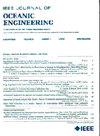概率粒子滤波锚定(PPFA):具有声光外感受传感器的自主水下航行器语义世界建模的新视角
IF 3.8
2区 工程技术
Q1 ENGINEERING, CIVIL
引用次数: 0
摘要
在自主水下航行器导航的场景中,创建精确的世界模型被认为是了解周围环境的关键阶段。因此,自动目标识别(ATR)体系结构检测到的目标及其定位位置必须经过处理、选择和过滤,以获得水下环境的符号表示。尽管具体的世界建模(WM)体系结构可能会有所不同,但目前的WM方法通常通过引入不可忽略的约束来依赖于被检测目标的三维定位知识。基于上述考虑,提出了一种新的概率粒子滤波锚定(PPFA)方法。从ATR 2-D结果开始,PPFA方法旨在通过合并数据关联和目标跟踪的优点,通过定制设计的带有重采样的粒子滤波器处理,提供海底环境的语义3-D表示。本文章由计算机程序翻译,如有差异,请以英文原文为准。
Probabilistic Particle Filter Anchoring (PPFA): A Novel Perspective in Semantic World Modeling for Autonomous Underwater Vehicles With Acoustic and Optical Exteroceptive Sensors
Creating an accurate world model of the scenario where an autonomous underwater vehicle is navigating can be considered a crucial stage for understanding the surrounding environment. As a result, the targets detected by an automatic target recognition (ATR) architecture alongside their localized positions, must be handled, selected, and filtered to get a symbolic representation of the underwater context. Even though the specific world modeling (WM) architecture may vary, current WM methodologies usually rely on the 3-D localization knowledge of the detected target by introducing a nonnegligible constraint. Motivated by the aforementioned considerations, a novel probabilistic particle filter anchoring (PPFA) approach has been developed. Starting from ATR 2-D results, the PPFA methodology aims at providing a semantic 3-D representation of the subsea environment by merging the upsides of both data association and object tracking, handled by a custom designed particle filter with resampling.
求助全文
通过发布文献求助,成功后即可免费获取论文全文。
去求助
来源期刊

IEEE Journal of Oceanic Engineering
工程技术-工程:大洋
CiteScore
9.60
自引率
12.20%
发文量
86
审稿时长
12 months
期刊介绍:
The IEEE Journal of Oceanic Engineering (ISSN 0364-9059) is the online-only quarterly publication of the IEEE Oceanic Engineering Society (IEEE OES). The scope of the Journal is the field of interest of the IEEE OES, which encompasses all aspects of science, engineering, and technology that address research, development, and operations pertaining to all bodies of water. This includes the creation of new capabilities and technologies from concept design through prototypes, testing, and operational systems to sense, explore, understand, develop, use, and responsibly manage natural resources.
 求助内容:
求助内容: 应助结果提醒方式:
应助结果提醒方式:


